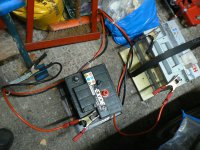Whilst clearing out my brother's car following his death (from natural causes) I found a set of budget jump leads in his boot.
and here they are, compared to my heavy duty commercial set:
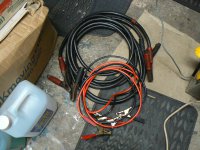
As you can see they look pretty "wimpy" but, on the other hand my big set is really intended for starting trucks!
Jump starting is an "art" in it's own right and needs a lot of understanding. The most important thing of all is to understand it's all about flowing large electrical currents. Anything which restricts this will reduce your chances of getting the engine started - assuming, of course, that a flat or partially discharged battery is the only problem. all other things being equal, a thin cable can't pass as large a current as a thick one and this is very evident when using my big cables which are definitely larger in diameter than is really needed to start the average car. However, when you get down to the sort of wire guage we see in this budget set then anything which reduces the ability of it to flow current will have a great effect.
When I was young and ignorant I bought an impressive set of jump leads at a Sunday market but quickly discovered they wouldn't start anything. When tried, even with a battery known to be good, they had very little effect with the engine either cranking slowly or not at all. Why not? Well I'd bought a set of leads made with aluminium wire! The problem was that the connections where the wires were crimped into the clamps were very poor and high resistance. There really wasn't a cure for this although I got them to work for a wee while by crushing the crimps in a vice. However a short while later the brittle aluminium wire broke. I'd completely wasted my money. So, lesson number one is buy a set which has copper wires and clamps which aren't made of "chocolate" and of a reasonable thickness - take a look at my pictures.
Next is to consider where restrictions might restrict the flow of electricity - remember we're hoping to flow large currents (quantity) of electricity so anywhere there's a poor connection is going to reduce the flow and if we've got some pretty marginal wire size already then we don't want to compound the problem by having a high resistance connection in the circuit. So, slide the insulating sleeve back where the wire is fixed to the clamp. Most are like this one and can be very easily slid back over the wire:
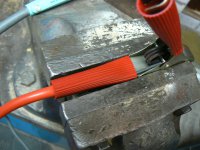
Having slid it back the connection underneath is most commonly a crimped one. And this one is a particularly poor example:
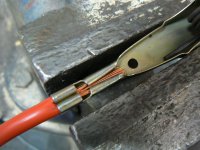
You can see all they've done is folded over the steel sides of the clamp and it's not even making contact with all the wires!
In this situation the best thing to do is just solder the whole thing up:
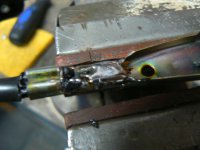
Which will give the best possible electrical connection but require a pretty substantial soldering iron or a gas torch. Another way of doing it is to get a proper eyelet type crimp connector. Crimp the wire into the eyelet, drill a hole in the clamp and screw the eyelet to the clamp. It's all about reducing the possibility for a high resistance at the connection.
Once you've improved this connection at all four ends of the two cables then slide the sleeve insulators back into place but make sure they are covering the ends of the clamp handles. If you push them on too far the metal ends of the handle can stick out and may later cause a short circuit when you're not being too careful:
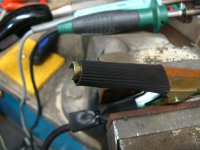
So make sure they are fitted so the metal ends don't protrude:
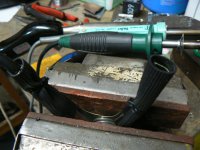
See what I mean? You'll see I've also secured these cheap flimsy sleeve insulators in place with small cable ties so they can't later slide down the handle. You may or may not need to do this depending on the set you're working with.
Personally I also like to have my cables tied together just to keep better control of them when in use so I leave about 18 inches free at either end so the connectors can be easily connected and tie the centre run together:

So now we've probably given this cheaply made set of jump cables a fair chance of working as well as can be expected.
As to actually jumping a vehicle? Well, right away I have to say, with modern vehicles and all their associated electronics, I'm not at all keen on jumping one vehicle to another. Surprisingly perhaps, many people do get away with it but the problem comes when the charging system on one pf the vehicles is "fooled" into producing a current spike by something it "sees" on the other vehicle. Current spikes and their associated high voltages can instantaneously "kill" electronic components - so, if it happens, you'll not be able to react quickly enough to stop it and it can get very very expensive sorting out the result. On the other hand, if you follow a few simple rules, you can jump start reasonably safely. I would be a fool to say it's 100% safe but it's unlikely you'll end up with a problem. And the "secret is? to only jump with another battery of the same voltage as that on the vehicle. This can be a dedicated jump pack like you see advertised in many places and they take many forms utilizing lead acid, Li-ion etc batteries. My own favourite of the moment are super capacitor types, and, what I've been using for years, a stand alone 12 volt car battery. I have two, a large one which was removed from my diesel Cordoba when I scrapped her and a smaller one from my boy's Punto when we replaced it with a new one.
So how to make the connections? Well, let's imagine the the smaller black battery is actually in the car and is the "flat" battery. The larger battery is the fully charged Jump battery - but could as easily be a jump pack or other.
So, first thing is to connect the positive terminal on one battery to the positive terminal on the other using the red lead:

Take great care as you fit the first clamp not to let the clamp on the other end of the cable come into contact with anything metal. Give the clamps a slight "wiggle" as you fit them to make sure the connection is good electrically. Of course the battery in the car will have the car's cables connected and it's normal to just clamp over the connectors. If you do this carefully there's very little that can go wrong.
Next take one of the black cable clamps and connect it to the negative terminal of the jump (fully charged) battery but again be very careful to keep the clamp on the other end isolated:

Now you might think the next thing to do is connect the other end of the black lead to the negative terminal on the car's battery? But DON'T! Instead look for an exposed metal part of the engine or gearbox (some cars will have a dedicated earthing point specifically for this purpose so take a look in your manual. However earthing this clamp to the engine block or gearbox casing will be just as good a connecting point. Making this connection here does two things. Firstly, if there is a small spark as you make the connection, then it's away from the battery which may be emitting flammable gas. (batteries produce hydrogen and oxygen when charging and discharging) They have been known to explode with very unpleasant results! A spark is always possible because you're connecting a fully charged battery to a discharged one so current will flow. Secondly, connecting in this way will. in most cases, include the Battery Condition Monitor ( a small electronic sensor on the negative battery terminal usually) in the system created by connecting the jump battery - which protects it from damage.
Now you've got the two systems connected. Imagine the earth clamp on the left of this next picture is actually connected to the engine block/gearbox case or dedicated earth on the vehicle:

and, of course that neg terminal on the black battery would have the car's negative cable still connected to it. So the black battery, in the car, would have the car's original cables still connected to both positive and negative terminal posts.
Now, because I use that nice big jump battery which has considerable capacity, I like to leave the two connected together like this for a few minutes, around 3 or 4 is probably enough. What this does is uses the charge in the big jump battery to put a surface charge on the plates in the flat battery. This brief charging doesn't deplete the jump battery by very much but it does greatly reduce the draw of the flat battery on the jump battery so when you finally hit the starter motor, which is what you do now, there's going to be plenty of "juice" for the starter to "lunch" on. If it starts, which it now has every chance of doing if all that's wrong is that the vehicle's own battery is depleted, DON'T immediately disconnect the jump battery. Let it run with the jump battery connected for about 5 minutes. Whatever you do DON'T immediately disconnect the jump battery. If the car's own battery is very flat then suddenly letting the car's charging system "see" the flat battery might make it "spike" it's output in an effort to compensate for this sudden drop in what it's seeing from the battery and this might blow something electronic.
So, having let it run for a wee while disconnect the leads in the reverse order to how you connected them. So the black negative clamp on the car's engine block/gearbox case/dedicated earth point comes off first. Then the other end of that cable from the jump battery's negative post. Then the two positive clamps. Being careful all the time not to let any of the "free" clamps touch anything to avoid the possibility of a short circuit.
If, like me, you choose to keep full size batteries for jumping - which I like because it gives you a much extended cranking time compared to other options but is pretty inconvenient because of size and weight for most people - then be VERY CAREFUL about how you store the batteries. I have post caps for the terminals on the black battery and a positive terminal shield for the big silver jobbie:

They fit like this:

They both "live" tucked under my trailer

and the big silver jobbie also has a plywood protector which fits on top

The intention is to prevent a short between the terminals which would be unnecessarily spectacular! and make a hell of a mess! But, joking aside, I know my precautions are not perfect and it's very very important not to let a fully charged battery be shorted out - there's a surprising amount of energy in one.
Having reflected on this overnight I think it's important to realize that jump starting always has risks attached to it, especially if you are inexperienced. There are the "mechanical" dangers implicit in such activity, for instance: The car might have been left in gear and will move when trying to start. You're going to be working under the bonnet with your hands near the "oily bits" so always make sure the ignition keys are in your pocket or, at least, not in the ignition switch so someone else can't come along and crank the engine. Of course, if the engine has been running recently there are going to be some very hot bits and pieces and other "stuff", like belts and pulleys can cause severe injury once the engine is running. There are some cars, Hondas come to mind, where if you leave the key in the ignition and disconnect the battery there's a very high possibility that the key coding will be corrupted and you won't then be able to start the car. If this happens then an expensive visit to the nearest main dealer will be required to have it reprogrammed! Daughter in law ran a 2008 Jazz which I looked after and since our local wee Honda specialist told me about this I've always put the car key - any car keys, not just Honda - on my workbench when fiddling with battery terminals, just in case.
The connections I've detailed above were how I was taught to do it many many years ago but back in those days the biggest danger was that you might initiate a spark when making the last connection and completing the circuit. By always making that last connection to a remote earth - chassis, engine, gearbox, or other suitable point remote from the battery - then it's unlikely any spark will ignite the battery gasses. (It's likely that if the battery has been "flogged" by recent attempts to start the car then it may have been gassing much more than normal so the explosion risk is much greater) This connection procedure has remained good practice on more modern vehicles where a battery condition monitor is installed on the negative battery terminal connection as it affords a degree of protection to it. I've jumped many vehicles over the years and just over the last few years a number of family and neighbour's vehicles by connecting in this way and never had any hint of a problem. However I am not an electronics engineer and can't guarantee that doing this won't cause damage to any particular vehicle you might try it on (modern electronics is progressing so quickly it's impossible for folk like us to keep up with it) So I have to warn you that if you decide to try jump starting using my above guide then there's always the possibility damage may be caused so, be clear about this, YOU TRY THIS AT YOUR OWN RISK! In days past it was very common to jump from one car to another but now a days I can not recommend jumping from one vehicle to another because of the risk of damaging electronic components.
Edit. It's now 2 days since I made the original post here and I thought I'd just add the following:
You're failure to start might well be due to a poor connection at the battery terminal. This can often be detected if you quickly, after attempting to start the vehicle, feel the terminal clamps with your hand. A terminal with a poor connection will often betray itself by feeling hot - and they can sometimes be REALLY HOT! so be careful. Of course this can be quickly and easily rectified if you can remove the clamp and clean it up. Be aware though that you may loose stored data by disconnecting a battery clamp.
Although I'm sure you'll have gathered that I don't advise jump starting vehicle to vehicle on anything with electronics - so pretty much all modern vehicles - if you feel you really REALLY must then buy a set of surge protected jump leads. Here's an example: https://www.drapertools.com/product/91884/surge-protection-booster-cables-5m-x-29mm/. Cheaper options are available and you can buy "clip on" versions which "piggy back" onto a standard set of leads. I've no idea how effective they are and I think just avoiding car to car jumps in the first place is a better option.
and here they are, compared to my heavy duty commercial set:

As you can see they look pretty "wimpy" but, on the other hand my big set is really intended for starting trucks!
Jump starting is an "art" in it's own right and needs a lot of understanding. The most important thing of all is to understand it's all about flowing large electrical currents. Anything which restricts this will reduce your chances of getting the engine started - assuming, of course, that a flat or partially discharged battery is the only problem. all other things being equal, a thin cable can't pass as large a current as a thick one and this is very evident when using my big cables which are definitely larger in diameter than is really needed to start the average car. However, when you get down to the sort of wire guage we see in this budget set then anything which reduces the ability of it to flow current will have a great effect.
When I was young and ignorant I bought an impressive set of jump leads at a Sunday market but quickly discovered they wouldn't start anything. When tried, even with a battery known to be good, they had very little effect with the engine either cranking slowly or not at all. Why not? Well I'd bought a set of leads made with aluminium wire! The problem was that the connections where the wires were crimped into the clamps were very poor and high resistance. There really wasn't a cure for this although I got them to work for a wee while by crushing the crimps in a vice. However a short while later the brittle aluminium wire broke. I'd completely wasted my money. So, lesson number one is buy a set which has copper wires and clamps which aren't made of "chocolate" and of a reasonable thickness - take a look at my pictures.
Next is to consider where restrictions might restrict the flow of electricity - remember we're hoping to flow large currents (quantity) of electricity so anywhere there's a poor connection is going to reduce the flow and if we've got some pretty marginal wire size already then we don't want to compound the problem by having a high resistance connection in the circuit. So, slide the insulating sleeve back where the wire is fixed to the clamp. Most are like this one and can be very easily slid back over the wire:

Having slid it back the connection underneath is most commonly a crimped one. And this one is a particularly poor example:

You can see all they've done is folded over the steel sides of the clamp and it's not even making contact with all the wires!
In this situation the best thing to do is just solder the whole thing up:

Which will give the best possible electrical connection but require a pretty substantial soldering iron or a gas torch. Another way of doing it is to get a proper eyelet type crimp connector. Crimp the wire into the eyelet, drill a hole in the clamp and screw the eyelet to the clamp. It's all about reducing the possibility for a high resistance at the connection.
Once you've improved this connection at all four ends of the two cables then slide the sleeve insulators back into place but make sure they are covering the ends of the clamp handles. If you push them on too far the metal ends of the handle can stick out and may later cause a short circuit when you're not being too careful:

So make sure they are fitted so the metal ends don't protrude:

See what I mean? You'll see I've also secured these cheap flimsy sleeve insulators in place with small cable ties so they can't later slide down the handle. You may or may not need to do this depending on the set you're working with.
Personally I also like to have my cables tied together just to keep better control of them when in use so I leave about 18 inches free at either end so the connectors can be easily connected and tie the centre run together:
So now we've probably given this cheaply made set of jump cables a fair chance of working as well as can be expected.
As to actually jumping a vehicle? Well, right away I have to say, with modern vehicles and all their associated electronics, I'm not at all keen on jumping one vehicle to another. Surprisingly perhaps, many people do get away with it but the problem comes when the charging system on one pf the vehicles is "fooled" into producing a current spike by something it "sees" on the other vehicle. Current spikes and their associated high voltages can instantaneously "kill" electronic components - so, if it happens, you'll not be able to react quickly enough to stop it and it can get very very expensive sorting out the result. On the other hand, if you follow a few simple rules, you can jump start reasonably safely. I would be a fool to say it's 100% safe but it's unlikely you'll end up with a problem. And the "secret is? to only jump with another battery of the same voltage as that on the vehicle. This can be a dedicated jump pack like you see advertised in many places and they take many forms utilizing lead acid, Li-ion etc batteries. My own favourite of the moment are super capacitor types, and, what I've been using for years, a stand alone 12 volt car battery. I have two, a large one which was removed from my diesel Cordoba when I scrapped her and a smaller one from my boy's Punto when we replaced it with a new one.
So how to make the connections? Well, let's imagine the the smaller black battery is actually in the car and is the "flat" battery. The larger battery is the fully charged Jump battery - but could as easily be a jump pack or other.
So, first thing is to connect the positive terminal on one battery to the positive terminal on the other using the red lead:
Take great care as you fit the first clamp not to let the clamp on the other end of the cable come into contact with anything metal. Give the clamps a slight "wiggle" as you fit them to make sure the connection is good electrically. Of course the battery in the car will have the car's cables connected and it's normal to just clamp over the connectors. If you do this carefully there's very little that can go wrong.
Next take one of the black cable clamps and connect it to the negative terminal of the jump (fully charged) battery but again be very careful to keep the clamp on the other end isolated:
Now you might think the next thing to do is connect the other end of the black lead to the negative terminal on the car's battery? But DON'T! Instead look for an exposed metal part of the engine or gearbox (some cars will have a dedicated earthing point specifically for this purpose so take a look in your manual. However earthing this clamp to the engine block or gearbox casing will be just as good a connecting point. Making this connection here does two things. Firstly, if there is a small spark as you make the connection, then it's away from the battery which may be emitting flammable gas. (batteries produce hydrogen and oxygen when charging and discharging) They have been known to explode with very unpleasant results! A spark is always possible because you're connecting a fully charged battery to a discharged one so current will flow. Secondly, connecting in this way will. in most cases, include the Battery Condition Monitor ( a small electronic sensor on the negative battery terminal usually) in the system created by connecting the jump battery - which protects it from damage.
Now you've got the two systems connected. Imagine the earth clamp on the left of this next picture is actually connected to the engine block/gearbox case or dedicated earth on the vehicle:
and, of course that neg terminal on the black battery would have the car's negative cable still connected to it. So the black battery, in the car, would have the car's original cables still connected to both positive and negative terminal posts.
Now, because I use that nice big jump battery which has considerable capacity, I like to leave the two connected together like this for a few minutes, around 3 or 4 is probably enough. What this does is uses the charge in the big jump battery to put a surface charge on the plates in the flat battery. This brief charging doesn't deplete the jump battery by very much but it does greatly reduce the draw of the flat battery on the jump battery so when you finally hit the starter motor, which is what you do now, there's going to be plenty of "juice" for the starter to "lunch" on. If it starts, which it now has every chance of doing if all that's wrong is that the vehicle's own battery is depleted, DON'T immediately disconnect the jump battery. Let it run with the jump battery connected for about 5 minutes. Whatever you do DON'T immediately disconnect the jump battery. If the car's own battery is very flat then suddenly letting the car's charging system "see" the flat battery might make it "spike" it's output in an effort to compensate for this sudden drop in what it's seeing from the battery and this might blow something electronic.
So, having let it run for a wee while disconnect the leads in the reverse order to how you connected them. So the black negative clamp on the car's engine block/gearbox case/dedicated earth point comes off first. Then the other end of that cable from the jump battery's negative post. Then the two positive clamps. Being careful all the time not to let any of the "free" clamps touch anything to avoid the possibility of a short circuit.
If, like me, you choose to keep full size batteries for jumping - which I like because it gives you a much extended cranking time compared to other options but is pretty inconvenient because of size and weight for most people - then be VERY CAREFUL about how you store the batteries. I have post caps for the terminals on the black battery and a positive terminal shield for the big silver jobbie:
They fit like this:
They both "live" tucked under my trailer
and the big silver jobbie also has a plywood protector which fits on top
The intention is to prevent a short between the terminals which would be unnecessarily spectacular! and make a hell of a mess! But, joking aside, I know my precautions are not perfect and it's very very important not to let a fully charged battery be shorted out - there's a surprising amount of energy in one.
Having reflected on this overnight I think it's important to realize that jump starting always has risks attached to it, especially if you are inexperienced. There are the "mechanical" dangers implicit in such activity, for instance: The car might have been left in gear and will move when trying to start. You're going to be working under the bonnet with your hands near the "oily bits" so always make sure the ignition keys are in your pocket or, at least, not in the ignition switch so someone else can't come along and crank the engine. Of course, if the engine has been running recently there are going to be some very hot bits and pieces and other "stuff", like belts and pulleys can cause severe injury once the engine is running. There are some cars, Hondas come to mind, where if you leave the key in the ignition and disconnect the battery there's a very high possibility that the key coding will be corrupted and you won't then be able to start the car. If this happens then an expensive visit to the nearest main dealer will be required to have it reprogrammed! Daughter in law ran a 2008 Jazz which I looked after and since our local wee Honda specialist told me about this I've always put the car key - any car keys, not just Honda - on my workbench when fiddling with battery terminals, just in case.
The connections I've detailed above were how I was taught to do it many many years ago but back in those days the biggest danger was that you might initiate a spark when making the last connection and completing the circuit. By always making that last connection to a remote earth - chassis, engine, gearbox, or other suitable point remote from the battery - then it's unlikely any spark will ignite the battery gasses. (It's likely that if the battery has been "flogged" by recent attempts to start the car then it may have been gassing much more than normal so the explosion risk is much greater) This connection procedure has remained good practice on more modern vehicles where a battery condition monitor is installed on the negative battery terminal connection as it affords a degree of protection to it. I've jumped many vehicles over the years and just over the last few years a number of family and neighbour's vehicles by connecting in this way and never had any hint of a problem. However I am not an electronics engineer and can't guarantee that doing this won't cause damage to any particular vehicle you might try it on (modern electronics is progressing so quickly it's impossible for folk like us to keep up with it) So I have to warn you that if you decide to try jump starting using my above guide then there's always the possibility damage may be caused so, be clear about this, YOU TRY THIS AT YOUR OWN RISK! In days past it was very common to jump from one car to another but now a days I can not recommend jumping from one vehicle to another because of the risk of damaging electronic components.
Edit. It's now 2 days since I made the original post here and I thought I'd just add the following:
You're failure to start might well be due to a poor connection at the battery terminal. This can often be detected if you quickly, after attempting to start the vehicle, feel the terminal clamps with your hand. A terminal with a poor connection will often betray itself by feeling hot - and they can sometimes be REALLY HOT! so be careful. Of course this can be quickly and easily rectified if you can remove the clamp and clean it up. Be aware though that you may loose stored data by disconnecting a battery clamp.
Although I'm sure you'll have gathered that I don't advise jump starting vehicle to vehicle on anything with electronics - so pretty much all modern vehicles - if you feel you really REALLY must then buy a set of surge protected jump leads. Here's an example: https://www.drapertools.com/product/91884/surge-protection-booster-cables-5m-x-29mm/. Cheaper options are available and you can buy "clip on" versions which "piggy back" onto a standard set of leads. I've no idea how effective they are and I think just avoiding car to car jumps in the first place is a better option.


